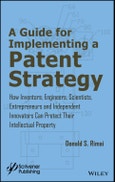This book provides a strategic framework for cost efficient engineering of market moving patent portfolios by organizing patent engineering efforts around the problems that innovators solve for their customers and not the technologies developed to solve these problems.
Patents are a vital asset in the modern business world. They allow patent holders to introduce new products in to a market while deterring other market players from simply copying innovative features without making comparable investments in research and development. In years past, a few patents may have provided adequate protection. That is no longer the case. In today's world, it is critical that innovative companies protect the features of their products that give them a competitive advantage with a family or portfolio of patents that are strategically generated to protect the market position of the patent holder. A patent portfolio that deters competitors from introducing competitive products in a timely manner can be worth billions of dollars. Anything less than this is an expensive and possibly fatal distraction. This book provides a strategic framework for cost efficient engineering of patent portfolios that protect your investments in research and development and that extend the market advantages that these investments provide.
The book illustrates the use of the problem centric framework to enable the efficient creation of individual patents and patent portfolios that have significant value in and by themselves and allow a company to control its product market. It also introduces the concept of a patent engineer whose role it is to organize input from legal, business and technical communities and organize portfolios and patents using the problem centric framework.
Table of Contents
1 Background for Developing and Implementing a Patent Strategy 1
2 The Structure of a Patent 17
3 The Path to Obtaining Patents 37
4 Identifying Patentable Inventions 47
5 Identifying What Has Yet to Be Invented 63
6 Prioritizing the Inventions 77
7 Prioritizing Your Patent Applications 91
8 Proposing and Writing Claims 107
9 Conducting Prior Art Searches 131
10 The Mindsets of Innovators and Attorneys and other Cautionary Notes 145
11 Reviewing Your Proposed Patent Applications 157
12 Writing Your Patent Applications 169
13 The Next Step: Prosecution of Your Patent Application 199
14 What Next? 221
15 Final Thoughts 245
Appendix 1 Electrophotography: Building a Patent Portfolio in a Mature but Evolving Field 255








